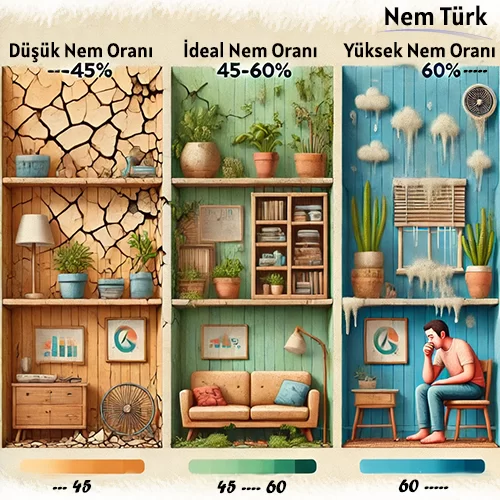The humidity level in an environment plays a crucial role in both human health and the longevity of structural elements. Any imbalance in humidity can cause serious harm not only to health but also to furniture, walls, concrete, and other building materials.
1. Maintaining the Correct Humidity Level
The ideal indoor relative humidity level should be between 45% and 60%. Falling below or exceeding this range can lead to several negative effects:
- Below 45%: Excessively dry air can cause building materials to crack and deteriorate.
- Above 60%: Creates favorable conditions for mold, fungi, and bacteria growth.
2. Harms of Low Humidity
When relative humidity drops below 45%, it can negatively affect both structural elements and human health.
a) Structural Damage:
- Building materials such as plaster, screed, and concrete can dry out, crack, or flake.
- Wooden floors and furniture may dry out over time and lose their shape.
- Increased electrical charging may lead to static electricity buildup.
b) Health Effects:
- Causes dryness and irritation in the respiratory tract, triggering asthma, bronchitis, and allergic reactions.
- Leads to dryness in the eyes, nose, and throat.
- Weakens the immune system, increasing the risk of infections.
3. Harms of High Humidity
When relative humidity exceeds 60%, it poses serious risks for both belongings and human health.
a) Structural Damage:
- Accelerates mold and fungus growth, leading to stains on walls, ceilings, and corners.
- Furniture, doors, and wooden floors may swell and deform due to moisture.
- Concrete, plaster, and painted surfaces may blister, crack, or peel.
- Items stored in warehouses—such as fabrics and documents—may decay over time.
b) Health Effects:
- Spores released by mold and fungi can cause respiratory diseases.
- May trigger asthma and allergic reactions.
- Can lead to skin problems such as itching and eczema.
- Causes nausea, headaches, and a general sense of fatigue.
4. The Importance of Maintaining Humidity Balance
To create a healthy and long-lasting living environment, humidity levels must be kept between 45% and 60%. For this purpose:
- Professional dehumidifiers can be used to keep humidity under control.
- Regular ventilation should be ensured to release excess moisture.
- Water leaks and damp areas should be detected and repaired quickly.
By taking these measures, not only can health problems be prevented, but the lifespan of building materials and household items can also be significantly extended.
